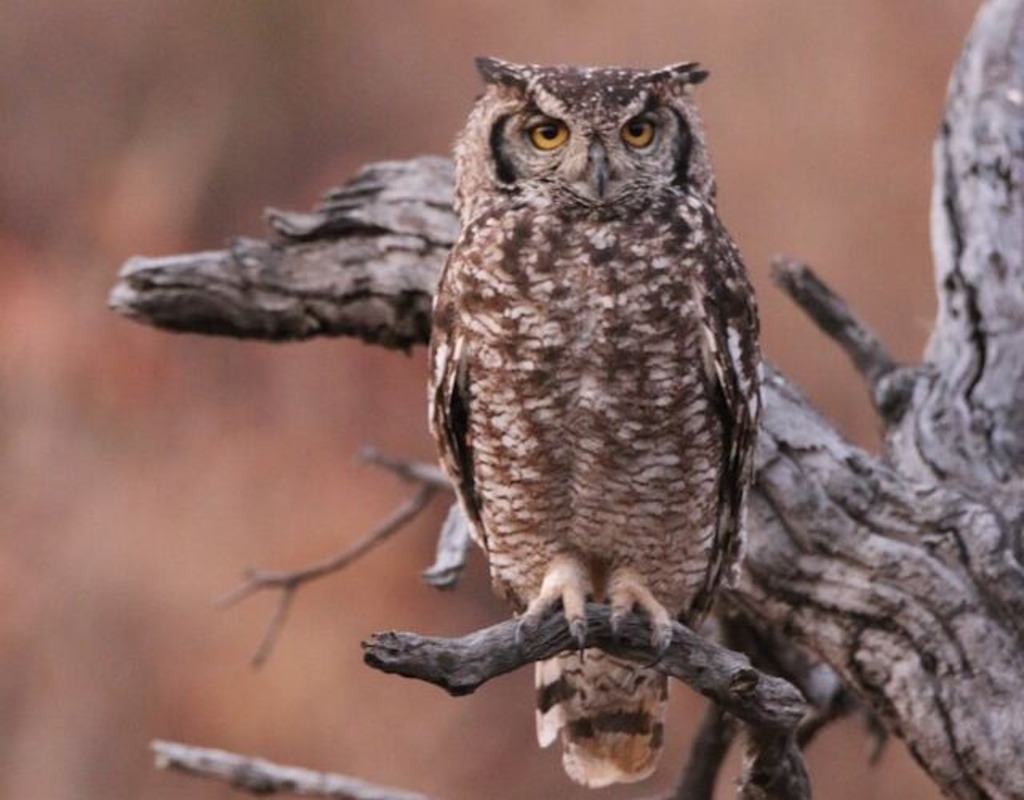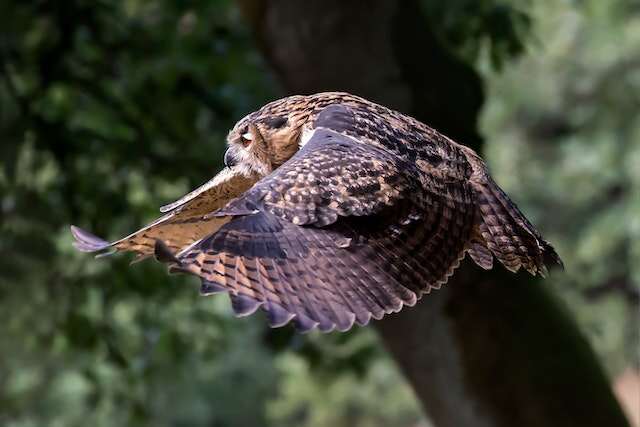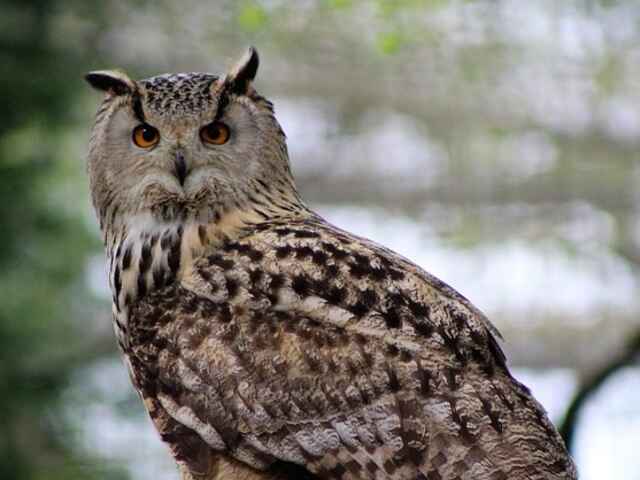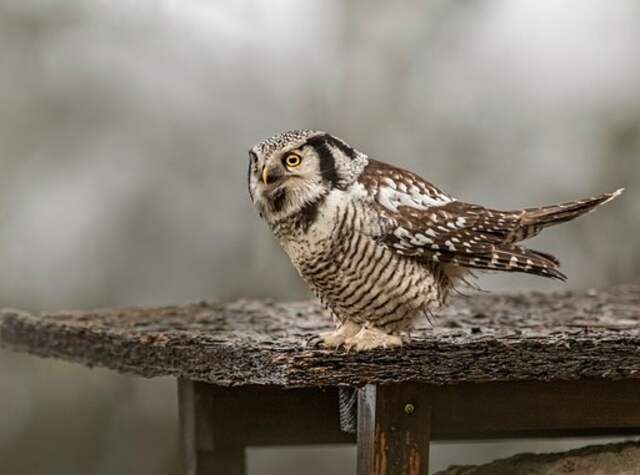Owls, with their silent flight and piercing eyes, are among nature’s most intriguing nocturnal predators. Bats, on the other hand, are often seen darting through the night sky, their echolocation guiding them in the dark. This naturally raises a compelling question: Do owls eat bats?
In this article, we dive into the fascinating world of owls and bats, examining whether owls actually prey on bats or if this is merely a myth. Join us as we separate fact from fiction and uncover the true nature of the relationship between these enigmatic night dwellers.
Table of Contents
Do Owls Eat Bats?
Yes, owls do eat bats. Some species of owls, such as the great horned owl and the barn owl, are known to consume bats as a regular part of their diet. Owls are nocturnal hunters and their diet typically consists of small mammals, birds, reptiles, and insects, including bats.
Types of Owls That Eat Bats
Owls are known for their diverse diets, which can include insects, rodents, small mammals, and even other birds. However, some species of owls have adapted to hunting bats as a primary food source. In this section, we will explore some of the types of owls that eat bats.
- Great Horned Owl: The Great Horned Owl is one of the largest owl species in North America and is a known predator of bats. This owl species can be found in a wide range of habitats, from forests to deserts, and is known for its exceptional night vision and powerful talons. Great Horned Owls are capable of taking down bats in mid-flight, thanks to their agility and hunting skills.
- Snowy Owl: The Snowy Owl is a magnificent bird that can be found in the Arctic regions of North America and Eurasia. Although their diet mainly consists of rodents and birds, Snowy Owls have been known to consume bats as well. During the winter months, when food is scarce, they will often hunt for bats to supplement their diet.
- Long-eared Owl: The Long-eared Owl is a medium-sized owl species that is found in many parts of the world. These birds are often identified by their distinctive ear tufts, which are not actually ears, but rather feathers that help them blend into their surroundings. Long-eared Owls are skilled hunters and have been known to consume bats, particularly during the breeding season when bats are more abundant.
- Short-eared Owl: The Short-eared Owl is a medium-sized owl species that can be found in many parts of the world, including North America, Europe, and Asia. These owls are known for their distinctive facial discs and their preference for hunting during the day. While they mainly feed on small mammals, they have been known to prey on bats as well.
- Barn Owls: Barn Owls are one of the most widespread owl species in the world, found on every continent except Antarctica. These birds are known for their distinctive heart-shaped facial disc and their ability to hunt in complete darkness. While they mainly feed on small mammals such as mice and voles, they are also known to consume bats.
- Northern Saw-whet Owls: The Northern Saw-whet Owl is a small owl species that can be found in many parts of North America. These birds are named after their distinctive call, which sounds like the sharpening of a saw. Northern Saw-whet Owls are skilled hunters and have been known to consume bats, particularly during the breeding season.
- Spectacled Owls: The Spectacled Owl is a large owl species that can be found in Central and South America. These birds are named after the distinctive white feathers around their eyes, which give them the appearance of wearing spectacles. While they mainly feed on small mammals, Spectacled Owls have been known to consume bats as well.
These owls have adapted to hunt bats as a primary food source, and their unique hunting skills and adaptations allow them to capture bats in flight or while roosting.
| Owl Species | Geographic Range | Known to Eat Bats? |
|---|---|---|
| Barn Owls | Widespread on every continent except Antarctica | Yes |
| Long-eared Owls | Found throughout the Northern Hemisphere | Yes |
| Short-eared Owls | Found throughout much of the world, including North America, Europe, and Asia | Yes |
| Northern Saw-whet Owls | Found in North America | Yes |
| Spectacled Owls | Found in Central and South America | Yes |
Types of Bats Eaten by Owls
Owls are known to consume a variety of bat species, with some types of owls being more likely to prey on bats than others. In general, smaller owls tend to feed on smaller bat species, while larger owls can consume larger bats.
The types of bats eaten by owls can vary depending on the region and habitat in which they live. Some of the bat species commonly preyed upon by owls include:
- Myotis spp. (Myotis bats)
- Eptesicus spp. (big brown bats)
- Pipistrellus spp. (pipistrelle bats)
- Nycticeius spp. (evening bats)
- Lasiurus spp. (hoary bats)
The size and type of bats consumed by owls can also vary depending on the owl species. For example, the Eastern Screech-Owl, a smaller species of owl found throughout North America, typically feeds on smaller bat species such as the little brown bat (Myotis lucifugus) or the Eastern pipistrelle (Pipistrellus subflavus).
In contrast, larger owls such as the Great Horned Owl have been known to prey on larger bat species such as the big brown bat (Eptesicus fuscus) or hoary bat (Lasiurus cinereus).
Bats are typically caught by owls in flight, with the owl using their sharp talons to grasp the bat out of the air. Once caught, the owl will use its sharp beak to bite the bat and kill it before consuming it.
In some cases, owls may also consume bats that have fallen to the ground or become trapped in vegetation. Owls have been known to hunt for bats near roosting sites, such as caves or hollow trees, where they can ambush their prey.
Overall, the consumption of bats by owls plays an important role in regulating bat populations and maintaining a healthy ecosystem.
| Owl species | Bat species preyed upon |
|---|---|
| Barn owl | Common pipistrelle, Soprano pipistrelle, Brown long-eared bat, Natterer’s bat |
| Great horned owl | Big brown bat, Mexican free-tailed bat, Brazilian free-tailed bat |
| Northern saw-whet owl | Little brown bat, Northern long-eared bat |
| Eastern screech owl | Eastern red bat, Hoary bat |
| Western screech owl | Pallid bat, Western small-footed bat |
Is It Common for Owls to Eat Bats?
Owls are known to be opportunistic predators that prey on a wide range of animals, including bats. However, the frequency at which they consume bats varies among different species of owls and also depends on other factors.
Frequency of Owls Eating Bats:
Bats are not a primary food source for most species of owls, and their consumption varies among different owl species. Some species, such as the Great Horned Owl, have been known to consume bats frequently, while others, like the Northern Saw-whet Owl, rarely consume them.
Research has shown that the frequency of owls consuming bats can also depend on the availability of other prey species in their habitat.
Factors Affecting the Consumption of Bats by Owls:
- Habitat: The availability of roosting and nesting sites for bats can influence the consumption of bats by owls. Bats tend to roost in dark, secluded places, such as caves, trees, and buildings. If these habitats are abundant in an owl’s habitat, then the likelihood of consuming bats increases.
- Seasonality: The availability of bats in an owl’s habitat can also depend on the time of year. During the breeding season, bats tend to congregate in large colonies, making them more accessible to predators, including owls.
- Diet: The diet of an owl can also influence the consumption of bats. Owls that primarily feed on small mammals, such as mice and voles, may consume bats less frequently than those that feed on a more diverse range of prey.
- Competition: Competition with other predators for prey can also affect the frequency of bat consumption by owls. If there are other predators in the area that consume bats, such as birds of prey or carnivorous mammals, then the frequency of bat consumption by owls may be lower.
| Factors Affecting the Consumption of Bats by Owls: | Impact on Consumption of Bats by Owls |
|---|---|
| Habitat | The availability of roosting and nesting sites for bats can influence the consumption of bats by owls. Bats tend to roost in dark, secluded places, such as caves, trees, and buildings. If these habitats are abundant in an owl’s habitat, then the likelihood of consuming bats increases. |
| Seasonality | The availability of bats in an owl’s habitat can also depend on the time of year. During the breeding season, bats tend to congregate in large colonies, making them more accessible to predators, including owls. |
| Diet | The diet of an owl can also influence the consumption of bats. Owls that primarily feed on small mammals, such as mice and voles, may consume bats less frequently than those that feed on a more diverse range of prey. |
| Competition | Competition with other predators for prey can also affect the frequency of bat consumption by owls. If there are other predators in the area that consume bats, such as birds of prey or carnivorous mammals, then the frequency of bat consumption by owls may be lower. |
Why Do Owls Eat Bats?
Owls are known to be nocturnal birds of prey, which means they are active and hunt during the night. One of the most interesting things about these birds is their varied diets.
While some owls primarily feed on rodents, insects, and small mammals, others have been observed consuming bats. But why do owls eat bats?
Possible Reasons For Owls Consuming Bats:
There are several reasons why owls might prey on bats. One of the primary reasons is the abundance of bats in the environment. In many areas, bats are a readily available food source, making them an easy target for owls.
Nutritional Benefits Of Eating Bats:
In addition to their abundance, bats also provide significant nutritional benefits to owls. Bats are high in protein and fat, which are essential nutrients for birds of prey. These nutrients provide the energy required for flying, hunting, and maintaining their bodies.
Reduction of competition for habitat and food sources: Another reason why owls eat bats is to reduce competition for habitat and food sources.
Owls and bats are both nocturnal hunters that occupy similar habitats. By consuming bats, owls reduce competition for resources, allowing them to thrive in their environment.
Similarities In Nocturnal Hunting Habits:
Finally, the nocturnal hunting habits of owls and bats may also contribute to why owls eat bats. Both creatures are active at night, making it easier for owls to locate and catch bats.
Owls are known for their exceptional hearing, which allows them to locate prey in complete darkness. Bats, on the other hand, use echolocation to navigate and hunt, emitting high-frequency sounds that owls can hear and used to track their movements.
In conclusion, there are several reasons why owls eat bats. Bats provide significant nutritional benefits to owls, are abundant in many environments, and their consumption by owls helps to reduce competition for habitat and food sources.
Additionally, the nocturnal hunting habits of both creatures may contribute to why owls prey on bats. Despite the potential risks associated with consuming bats, owls have developed unique adaptations that allow them to safely consume these flying mammals.
| Reasons | Explanation |
|---|---|
| Abundance | Bats are readily available in many areas, making them an easy target for owls. |
| Nutritional Benefits | Bats are high in protein and fat, providing essential nutrients for owls. |
| Reduction of Competition | By consuming bats, owls reduce competition for resources and can thrive in their environment. |
| Nocturnal Hunting Habits | Owls and bats are both active at night, making it easier for owls to locate and catch bats. |
| Hearing and Echolocation | Owls have exceptional hearing, and bats use echolocation, which can help owls track their movements. |
Risks Associated With Owls Eating Bats
While it is natural for owls to consume bats, there are some potential risks associated with this behavior. These risks can impact both the owl and bat populations in different ways. In this section, we will explore some of the potential risks associated with owls eating bats.
Potential Dangers For Both Owls And Bats When Owls Consume Bats
When owls consume bats, there are some potential dangers for both species. For the owl, eating bats that have been exposed to pesticides or other toxins can have a negative impact on their health. This can lead to reduced reproductive success, developmental abnormalities, and even death.
For the bats, being consumed by owls can also be dangerous. If the owl does not kill the bat immediately, it can cause unnecessary stress and suffering. Additionally, owls may transmit diseases to bats, which can lead to the spread of illness within bat populations.
Impact On Bat Populations
While owls may help to control bat populations, their consumption of bats can also have a negative impact. Some species of bats are already facing population declines due to habitat loss, disease, and other factors. When owls consume these bats, it can contribute to further declines in bat populations.
The absence of bats could cause detrimental effects on ecosystems as they are crucial for pollination, seed dispersal, and insect control. In their absence, plant and animal populations may face negative consequences due to the disruption of these vital ecosystem services.
In conclusion, while it is natural for owls to consume bats, there are potential risks associated with this behavior. These risks can impact both the owl and bat populations, as well as ecosystem services.
It is important to consider these risks when studying the interactions between owls and bats, and to implement measures to mitigate any negative impacts on both species.
| Risks Associated with Owls Eating Bats | Potential Dangers for Both Owls and Bats When Owls Consume Bats | Impact on Bat Populations |
|---|---|---|
| Exposure to toxins and pesticides | Reduced reproductive success, developmental abnormalities, and death in owls | Further declines in bat populations |
| Unnecessary stress and suffering in bats | Disease transmission from owls to bats | Disruption of ecosystem services |
Other Prey Consumed by Owls
Owls are known for their diverse diet and their ability to hunt a wide range of prey. While some species of owls primarily feed on rodents and small mammals, others have been observed consuming reptiles, amphibians, fish, and even other birds.
Here, we will take a closer look at some of the other prey consumed by owls, in addition to bats.
Rodents and Small Mammals
Rodents and small mammals are the most common prey for many species of owls. This includes mice, voles, rats, shrews, and rabbits. Owls have evolved specialized adaptations that allow them to capture these prey items, such as sharp talons, keen eyesight, and silent flight.
Reptiles and Amphibians
Some species of owls have also been observed consuming reptiles and amphibians. This includes snakes, lizards, frogs, and toads. Owls that live in wetland habitats, such as the great horned owl and the barn owl, are known to consume a larger proportion of amphibians in their diet.
Fish
A few species of owls, such as the fishing owl and the snowy owl, have been known to consume fish. Fishing owls, as their name suggests, are specialized in catching fish and are found in tropical regions of Africa and Asia. Snowy owls, on the other hand, have been observed hunting fish in the Arctic regions of North America.
Other Birds
While most species of owls primarily feed on small mammals, some larger owls have been observed consuming other birds. This includes the great horned owl, which is known to prey on smaller owls and birds of prey, as well as the eagle owl, which has been observed consuming crows, magpies, and other birds.
Other Animals That Eat Bats
Bats are not only consumed by owls, but also by other predators such as snakes, birds of prey, and some carnivorous mammals. For example, snakes such as the rattlesnake and the copperhead have been known to consume bats.
Birds of prey such as the peregrine falcon and the Cooper’s hawk have also been observed preying on bats. In addition, some carnivorous mammals such as raccoons, opossums, and even some primates have been known to consume bats.
| Prey | Examples of Owls that Consume Them |
|---|---|
| Rodents and Small Mammals | Most species of owls |
| Reptiles and Amphibians | Great horned owl, barn owl |
| Fish | Fishing owl, snowy owl |
| Other Birds | Great horned owl, eagle owl |
| Bats | Most species of owls, snakes, birds of prey, and |
| some carnivorous mammals such as raccoons and | |
| opossums. |
Conclusion
In conclusion, it is clear that owls do eat bats, but it varies depending on the species of owl and the type of bat. Owls have evolved to be highly skilled hunters, and their diet consists of a wide variety of prey, including insects, rodents, birds, and even other owls.
Despite the fact that bats are a common prey for many owl species, they are not the only food source, and owls have a varied diet to meet their nutritional needs.
The relationship between owls and bats is complex, and further research is needed to fully understand the ecological significance of these interactions.
Related Post: Do Owls Eat Birds? Understanding the Owl’s Eating Habits!









